Corporations Law Case Study: Buybacks and Shareholder Actions
VerifiedAdded on 2020/03/16
|5
|1477
|48
Case Study
AI Summary
This case study examines several key issues in Corporations Law. The first issue addresses whether the Galli grandchildren have grounds for action regarding unpaid dividends, considering the directors' discretion and the application of the Corporations Act 2001, particularly section 232 and 233, and the principles established in Thomas v H W Thomas Ltd. The second issue explores the potential benefits of a share buyback for the company, outlining the relevant procedures under Division 2 of Part 2J.1 of the Corporations Act and the role of an independent expert valuation. The final issue compares share buybacks with capital reduction, assessing the advantages and requirements of each option under section 256C of the Corporations Act, and concluding with a recommendation for the company's best course of action.
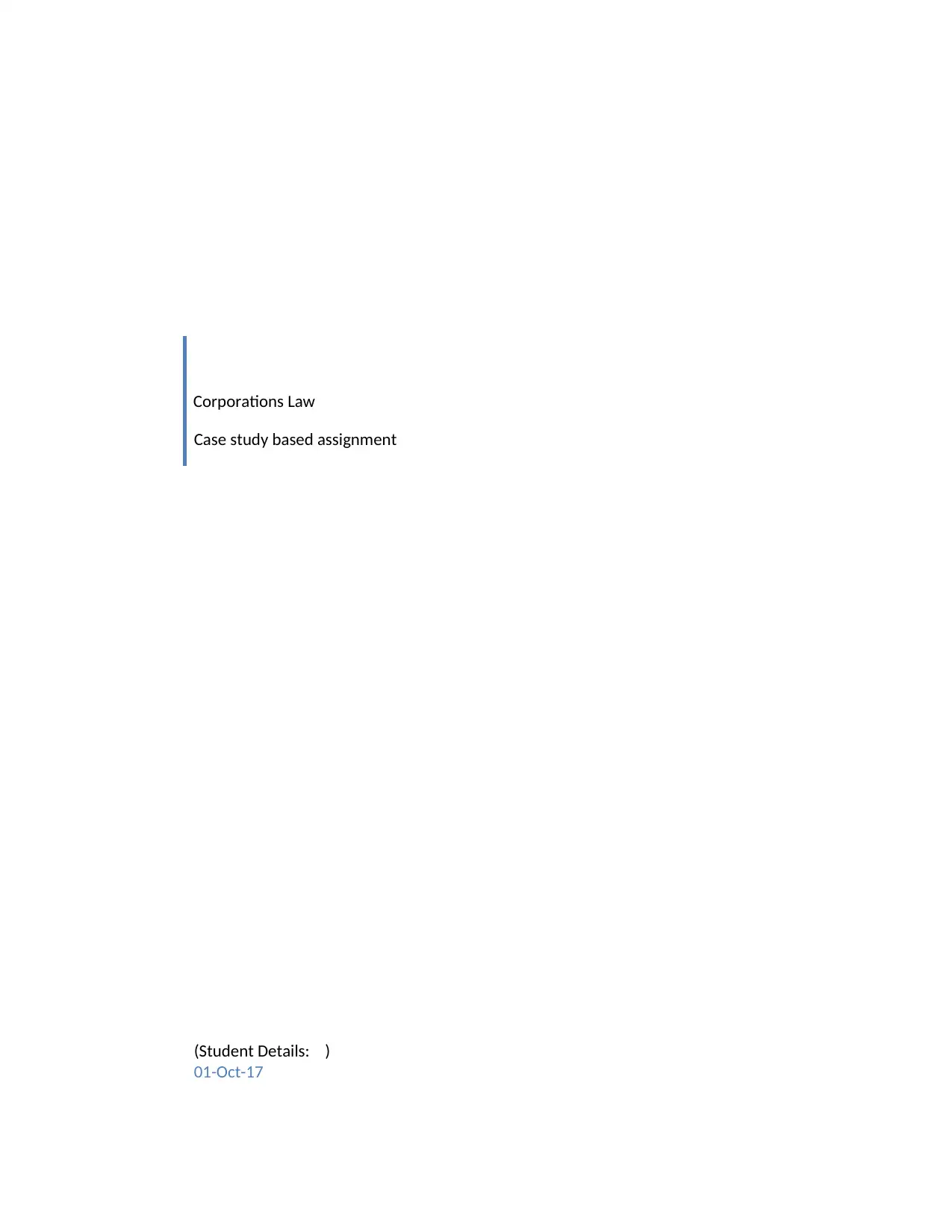
Corporations Law
Case study based assignment
(Student Details: )
01-Oct-17
Case study based assignment
(Student Details: )
01-Oct-17
Paraphrase This Document
Need a fresh take? Get an instant paraphrase of this document with our AI Paraphraser
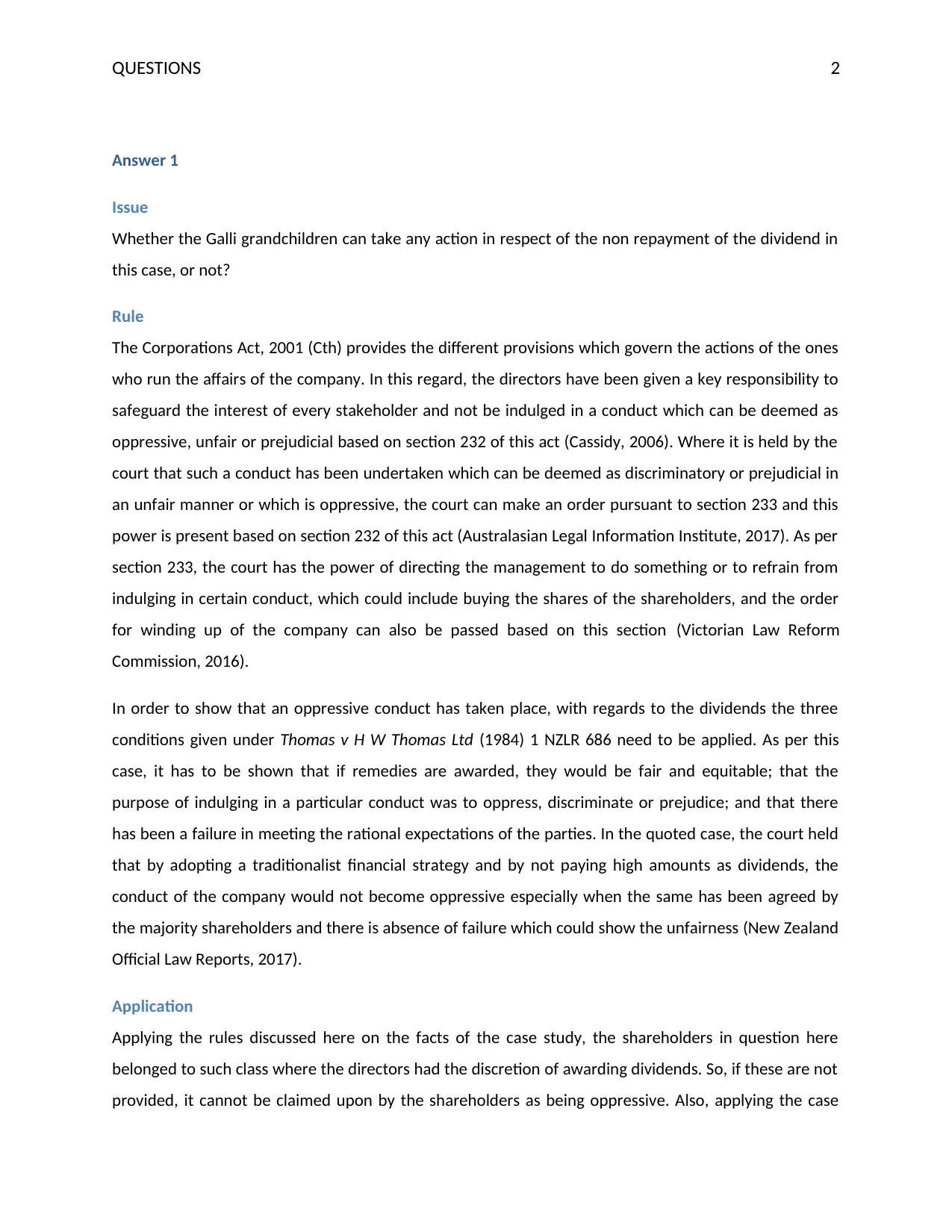
QUESTIONS 2
Answer 1
Issue
Whether the Galli grandchildren can take any action in respect of the non repayment of the dividend in
this case, or not?
Rule
The Corporations Act, 2001 (Cth) provides the different provisions which govern the actions of the ones
who run the affairs of the company. In this regard, the directors have been given a key responsibility to
safeguard the interest of every stakeholder and not be indulged in a conduct which can be deemed as
oppressive, unfair or prejudicial based on section 232 of this act (Cassidy, 2006). Where it is held by the
court that such a conduct has been undertaken which can be deemed as discriminatory or prejudicial in
an unfair manner or which is oppressive, the court can make an order pursuant to section 233 and this
power is present based on section 232 of this act (Australasian Legal Information Institute, 2017). As per
section 233, the court has the power of directing the management to do something or to refrain from
indulging in certain conduct, which could include buying the shares of the shareholders, and the order
for winding up of the company can also be passed based on this section (Victorian Law Reform
Commission, 2016).
In order to show that an oppressive conduct has taken place, with regards to the dividends the three
conditions given under Thomas v H W Thomas Ltd (1984) 1 NZLR 686 need to be applied. As per this
case, it has to be shown that if remedies are awarded, they would be fair and equitable; that the
purpose of indulging in a particular conduct was to oppress, discriminate or prejudice; and that there
has been a failure in meeting the rational expectations of the parties. In the quoted case, the court held
that by adopting a traditionalist financial strategy and by not paying high amounts as dividends, the
conduct of the company would not become oppressive especially when the same has been agreed by
the majority shareholders and there is absence of failure which could show the unfairness (New Zealand
Official Law Reports, 2017).
Application
Applying the rules discussed here on the facts of the case study, the shareholders in question here
belonged to such class where the directors had the discretion of awarding dividends. So, if these are not
provided, it cannot be claimed upon by the shareholders as being oppressive. Also, applying the case
Answer 1
Issue
Whether the Galli grandchildren can take any action in respect of the non repayment of the dividend in
this case, or not?
Rule
The Corporations Act, 2001 (Cth) provides the different provisions which govern the actions of the ones
who run the affairs of the company. In this regard, the directors have been given a key responsibility to
safeguard the interest of every stakeholder and not be indulged in a conduct which can be deemed as
oppressive, unfair or prejudicial based on section 232 of this act (Cassidy, 2006). Where it is held by the
court that such a conduct has been undertaken which can be deemed as discriminatory or prejudicial in
an unfair manner or which is oppressive, the court can make an order pursuant to section 233 and this
power is present based on section 232 of this act (Australasian Legal Information Institute, 2017). As per
section 233, the court has the power of directing the management to do something or to refrain from
indulging in certain conduct, which could include buying the shares of the shareholders, and the order
for winding up of the company can also be passed based on this section (Victorian Law Reform
Commission, 2016).
In order to show that an oppressive conduct has taken place, with regards to the dividends the three
conditions given under Thomas v H W Thomas Ltd (1984) 1 NZLR 686 need to be applied. As per this
case, it has to be shown that if remedies are awarded, they would be fair and equitable; that the
purpose of indulging in a particular conduct was to oppress, discriminate or prejudice; and that there
has been a failure in meeting the rational expectations of the parties. In the quoted case, the court held
that by adopting a traditionalist financial strategy and by not paying high amounts as dividends, the
conduct of the company would not become oppressive especially when the same has been agreed by
the majority shareholders and there is absence of failure which could show the unfairness (New Zealand
Official Law Reports, 2017).
Application
Applying the rules discussed here on the facts of the case study, the shareholders in question here
belonged to such class where the directors had the discretion of awarding dividends. So, if these are not
provided, it cannot be claimed upon by the shareholders as being oppressive. Also, applying the case
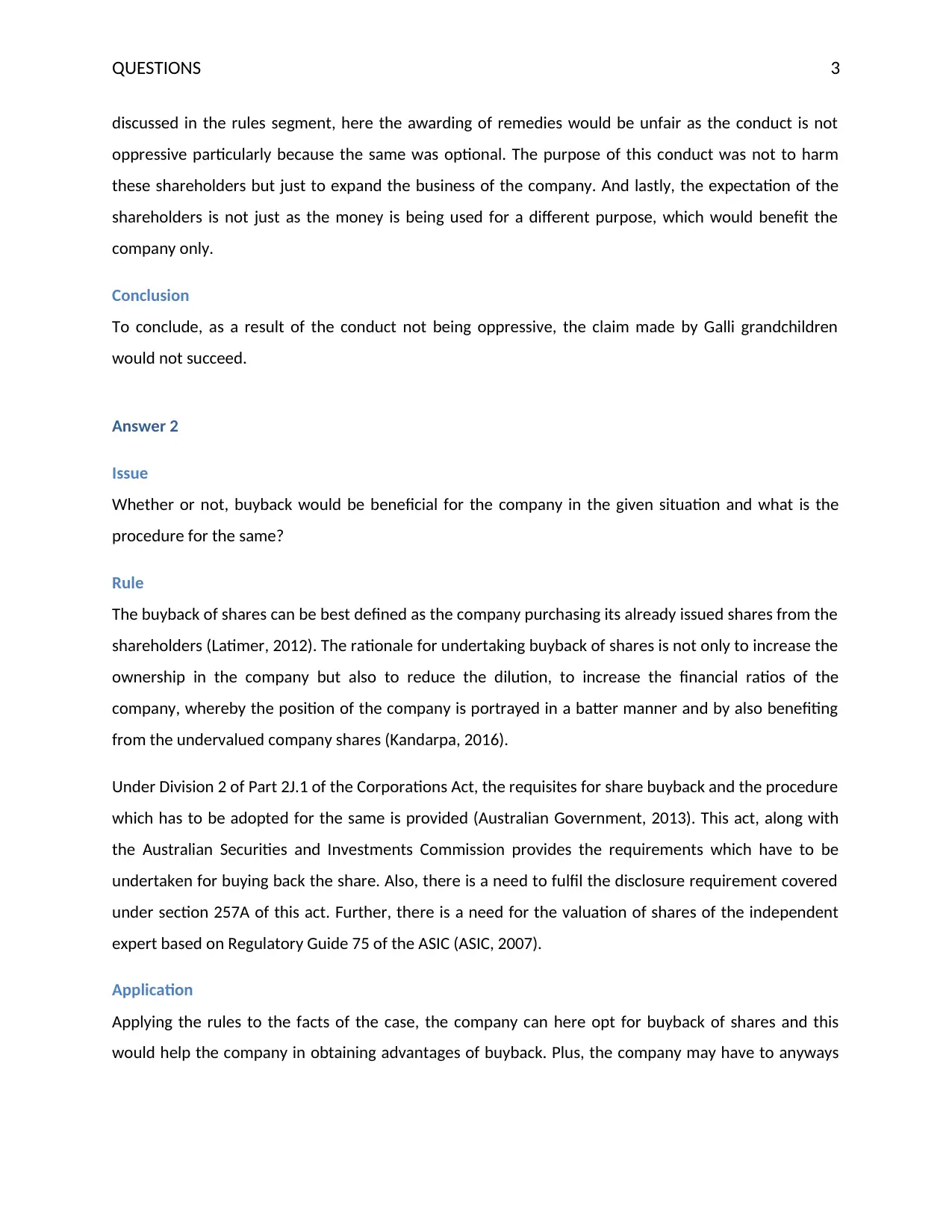
QUESTIONS 3
discussed in the rules segment, here the awarding of remedies would be unfair as the conduct is not
oppressive particularly because the same was optional. The purpose of this conduct was not to harm
these shareholders but just to expand the business of the company. And lastly, the expectation of the
shareholders is not just as the money is being used for a different purpose, which would benefit the
company only.
Conclusion
To conclude, as a result of the conduct not being oppressive, the claim made by Galli grandchildren
would not succeed.
Answer 2
Issue
Whether or not, buyback would be beneficial for the company in the given situation and what is the
procedure for the same?
Rule
The buyback of shares can be best defined as the company purchasing its already issued shares from the
shareholders (Latimer, 2012). The rationale for undertaking buyback of shares is not only to increase the
ownership in the company but also to reduce the dilution, to increase the financial ratios of the
company, whereby the position of the company is portrayed in a batter manner and by also benefiting
from the undervalued company shares (Kandarpa, 2016).
Under Division 2 of Part 2J.1 of the Corporations Act, the requisites for share buyback and the procedure
which has to be adopted for the same is provided (Australian Government, 2013). This act, along with
the Australian Securities and Investments Commission provides the requirements which have to be
undertaken for buying back the share. Also, there is a need to fulfil the disclosure requirement covered
under section 257A of this act. Further, there is a need for the valuation of shares of the independent
expert based on Regulatory Guide 75 of the ASIC (ASIC, 2007).
Application
Applying the rules to the facts of the case, the company can here opt for buyback of shares and this
would help the company in obtaining advantages of buyback. Plus, the company may have to anyways
discussed in the rules segment, here the awarding of remedies would be unfair as the conduct is not
oppressive particularly because the same was optional. The purpose of this conduct was not to harm
these shareholders but just to expand the business of the company. And lastly, the expectation of the
shareholders is not just as the money is being used for a different purpose, which would benefit the
company only.
Conclusion
To conclude, as a result of the conduct not being oppressive, the claim made by Galli grandchildren
would not succeed.
Answer 2
Issue
Whether or not, buyback would be beneficial for the company in the given situation and what is the
procedure for the same?
Rule
The buyback of shares can be best defined as the company purchasing its already issued shares from the
shareholders (Latimer, 2012). The rationale for undertaking buyback of shares is not only to increase the
ownership in the company but also to reduce the dilution, to increase the financial ratios of the
company, whereby the position of the company is portrayed in a batter manner and by also benefiting
from the undervalued company shares (Kandarpa, 2016).
Under Division 2 of Part 2J.1 of the Corporations Act, the requisites for share buyback and the procedure
which has to be adopted for the same is provided (Australian Government, 2013). This act, along with
the Australian Securities and Investments Commission provides the requirements which have to be
undertaken for buying back the share. Also, there is a need to fulfil the disclosure requirement covered
under section 257A of this act. Further, there is a need for the valuation of shares of the independent
expert based on Regulatory Guide 75 of the ASIC (ASIC, 2007).
Application
Applying the rules to the facts of the case, the company can here opt for buyback of shares and this
would help the company in obtaining advantages of buyback. Plus, the company may have to anyways
⊘ This is a preview!⊘
Do you want full access?
Subscribe today to unlock all pages.

Trusted by 1+ million students worldwide
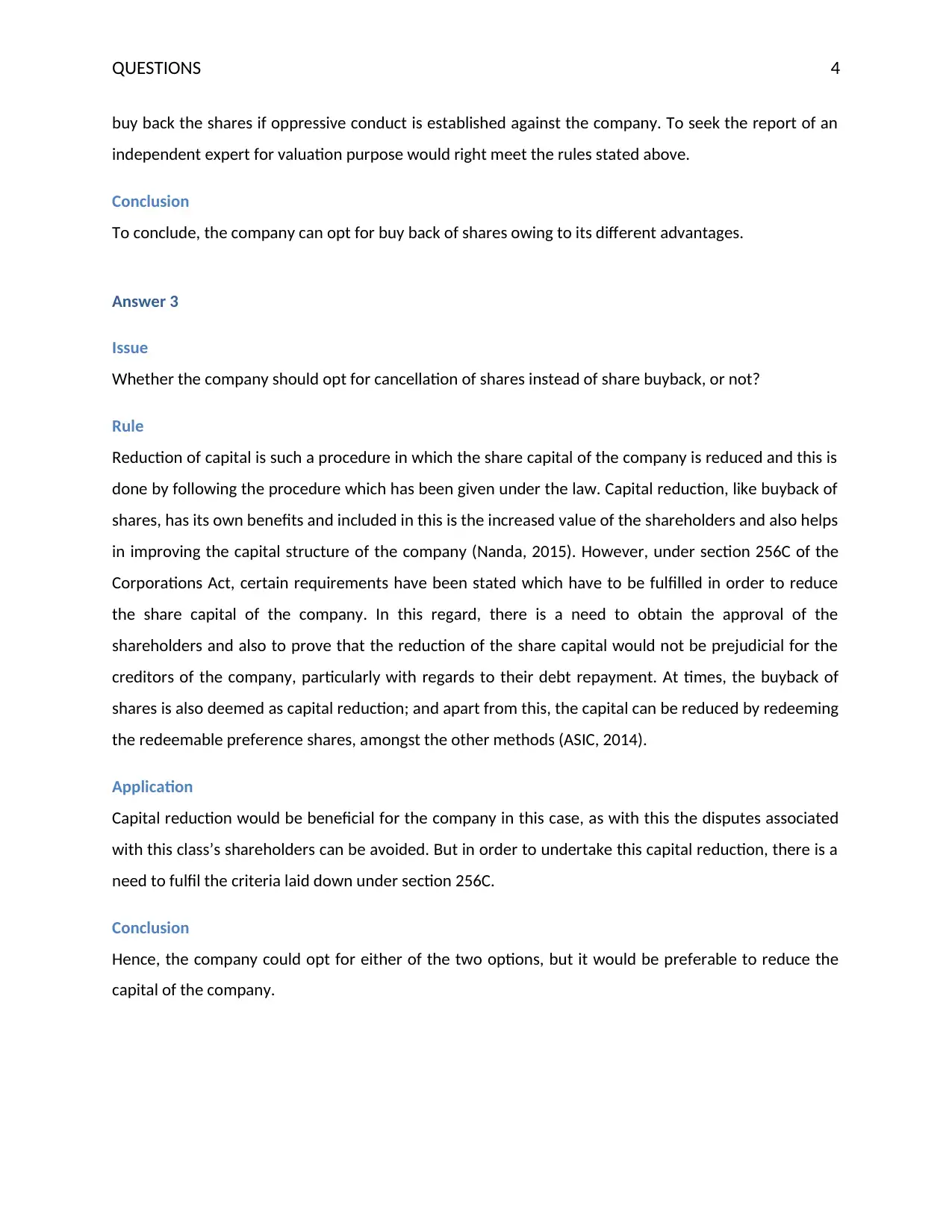
QUESTIONS 4
buy back the shares if oppressive conduct is established against the company. To seek the report of an
independent expert for valuation purpose would right meet the rules stated above.
Conclusion
To conclude, the company can opt for buy back of shares owing to its different advantages.
Answer 3
Issue
Whether the company should opt for cancellation of shares instead of share buyback, or not?
Rule
Reduction of capital is such a procedure in which the share capital of the company is reduced and this is
done by following the procedure which has been given under the law. Capital reduction, like buyback of
shares, has its own benefits and included in this is the increased value of the shareholders and also helps
in improving the capital structure of the company (Nanda, 2015). However, under section 256C of the
Corporations Act, certain requirements have been stated which have to be fulfilled in order to reduce
the share capital of the company. In this regard, there is a need to obtain the approval of the
shareholders and also to prove that the reduction of the share capital would not be prejudicial for the
creditors of the company, particularly with regards to their debt repayment. At times, the buyback of
shares is also deemed as capital reduction; and apart from this, the capital can be reduced by redeeming
the redeemable preference shares, amongst the other methods (ASIC, 2014).
Application
Capital reduction would be beneficial for the company in this case, as with this the disputes associated
with this class’s shareholders can be avoided. But in order to undertake this capital reduction, there is a
need to fulfil the criteria laid down under section 256C.
Conclusion
Hence, the company could opt for either of the two options, but it would be preferable to reduce the
capital of the company.
buy back the shares if oppressive conduct is established against the company. To seek the report of an
independent expert for valuation purpose would right meet the rules stated above.
Conclusion
To conclude, the company can opt for buy back of shares owing to its different advantages.
Answer 3
Issue
Whether the company should opt for cancellation of shares instead of share buyback, or not?
Rule
Reduction of capital is such a procedure in which the share capital of the company is reduced and this is
done by following the procedure which has been given under the law. Capital reduction, like buyback of
shares, has its own benefits and included in this is the increased value of the shareholders and also helps
in improving the capital structure of the company (Nanda, 2015). However, under section 256C of the
Corporations Act, certain requirements have been stated which have to be fulfilled in order to reduce
the share capital of the company. In this regard, there is a need to obtain the approval of the
shareholders and also to prove that the reduction of the share capital would not be prejudicial for the
creditors of the company, particularly with regards to their debt repayment. At times, the buyback of
shares is also deemed as capital reduction; and apart from this, the capital can be reduced by redeeming
the redeemable preference shares, amongst the other methods (ASIC, 2014).
Application
Capital reduction would be beneficial for the company in this case, as with this the disputes associated
with this class’s shareholders can be avoided. But in order to undertake this capital reduction, there is a
need to fulfil the criteria laid down under section 256C.
Conclusion
Hence, the company could opt for either of the two options, but it would be preferable to reduce the
capital of the company.
Paraphrase This Document
Need a fresh take? Get an instant paraphrase of this document with our AI Paraphraser
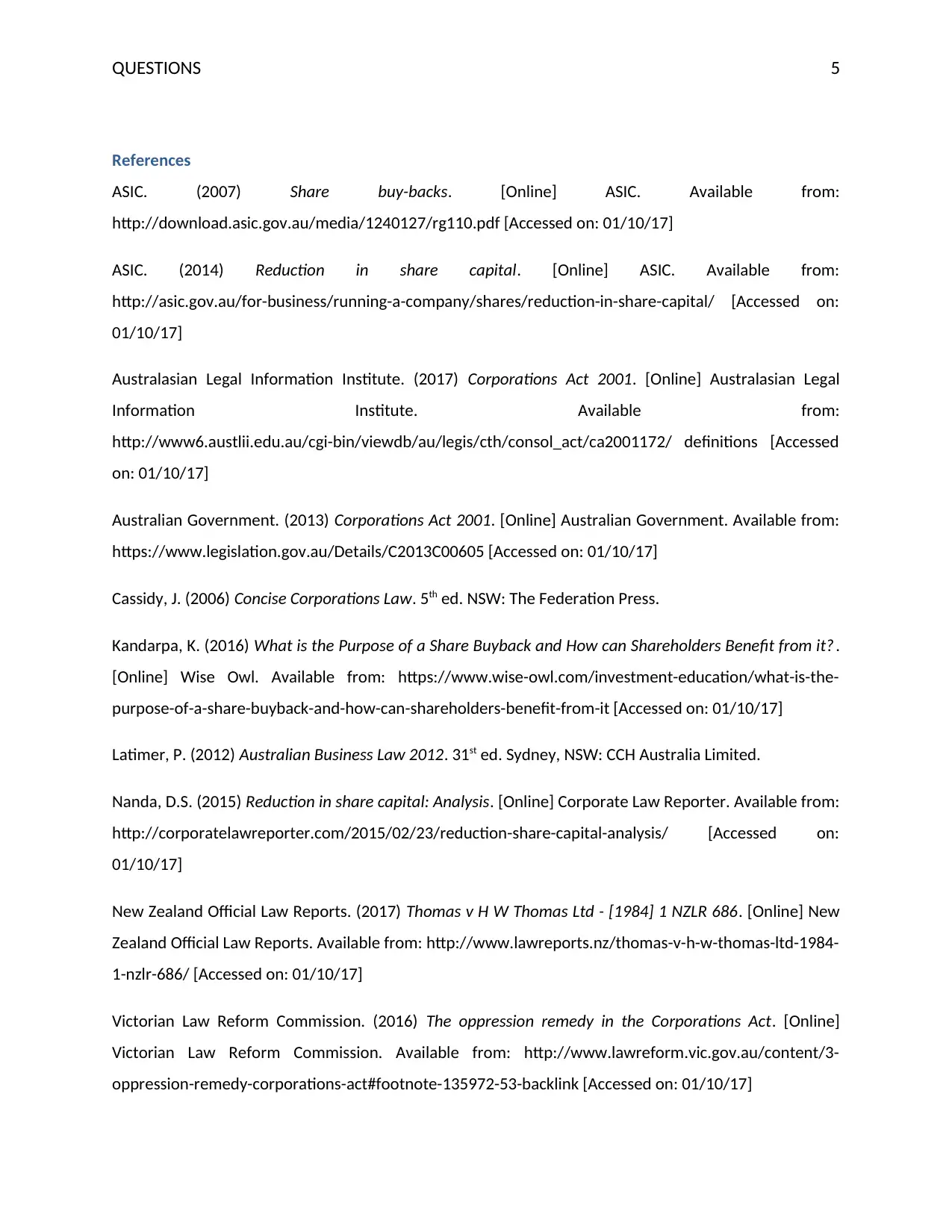
QUESTIONS 5
References
ASIC. (2007) Share buy-backs. [Online] ASIC. Available from:
http://download.asic.gov.au/media/1240127/rg110.pdf [Accessed on: 01/10/17]
ASIC. (2014) Reduction in share capital. [Online] ASIC. Available from:
http://asic.gov.au/for-business/running-a-company/shares/reduction-in-share-capital/ [Accessed on:
01/10/17]
Australasian Legal Information Institute. (2017) Corporations Act 2001. [Online] Australasian Legal
Information Institute. Available from:
http://www6.austlii.edu.au/cgi-bin/viewdb/au/legis/cth/consol_act/ca2001172/ definitions [Accessed
on: 01/10/17]
Australian Government. (2013) Corporations Act 2001. [Online] Australian Government. Available from:
https://www.legislation.gov.au/Details/C2013C00605 [Accessed on: 01/10/17]
Cassidy, J. (2006) Concise Corporations Law. 5th ed. NSW: The Federation Press.
Kandarpa, K. (2016) What is the Purpose of a Share Buyback and How can Shareholders Benefit from it? .
[Online] Wise Owl. Available from: https://www.wise-owl.com/investment-education/what-is-the-
purpose-of-a-share-buyback-and-how-can-shareholders-benefit-from-it [Accessed on: 01/10/17]
Latimer, P. (2012) Australian Business Law 2012. 31st ed. Sydney, NSW: CCH Australia Limited.
Nanda, D.S. (2015) Reduction in share capital: Analysis. [Online] Corporate Law Reporter. Available from:
http://corporatelawreporter.com/2015/02/23/reduction-share-capital-analysis/ [Accessed on:
01/10/17]
New Zealand Official Law Reports. (2017) Thomas v H W Thomas Ltd - [1984] 1 NZLR 686. [Online] New
Zealand Official Law Reports. Available from: http://www.lawreports.nz/thomas-v-h-w-thomas-ltd-1984-
1-nzlr-686/ [Accessed on: 01/10/17]
Victorian Law Reform Commission. (2016) The oppression remedy in the Corporations Act. [Online]
Victorian Law Reform Commission. Available from: http://www.lawreform.vic.gov.au/content/3-
oppression-remedy-corporations-act#footnote-135972-53-backlink [Accessed on: 01/10/17]
References
ASIC. (2007) Share buy-backs. [Online] ASIC. Available from:
http://download.asic.gov.au/media/1240127/rg110.pdf [Accessed on: 01/10/17]
ASIC. (2014) Reduction in share capital. [Online] ASIC. Available from:
http://asic.gov.au/for-business/running-a-company/shares/reduction-in-share-capital/ [Accessed on:
01/10/17]
Australasian Legal Information Institute. (2017) Corporations Act 2001. [Online] Australasian Legal
Information Institute. Available from:
http://www6.austlii.edu.au/cgi-bin/viewdb/au/legis/cth/consol_act/ca2001172/ definitions [Accessed
on: 01/10/17]
Australian Government. (2013) Corporations Act 2001. [Online] Australian Government. Available from:
https://www.legislation.gov.au/Details/C2013C00605 [Accessed on: 01/10/17]
Cassidy, J. (2006) Concise Corporations Law. 5th ed. NSW: The Federation Press.
Kandarpa, K. (2016) What is the Purpose of a Share Buyback and How can Shareholders Benefit from it? .
[Online] Wise Owl. Available from: https://www.wise-owl.com/investment-education/what-is-the-
purpose-of-a-share-buyback-and-how-can-shareholders-benefit-from-it [Accessed on: 01/10/17]
Latimer, P. (2012) Australian Business Law 2012. 31st ed. Sydney, NSW: CCH Australia Limited.
Nanda, D.S. (2015) Reduction in share capital: Analysis. [Online] Corporate Law Reporter. Available from:
http://corporatelawreporter.com/2015/02/23/reduction-share-capital-analysis/ [Accessed on:
01/10/17]
New Zealand Official Law Reports. (2017) Thomas v H W Thomas Ltd - [1984] 1 NZLR 686. [Online] New
Zealand Official Law Reports. Available from: http://www.lawreports.nz/thomas-v-h-w-thomas-ltd-1984-
1-nzlr-686/ [Accessed on: 01/10/17]
Victorian Law Reform Commission. (2016) The oppression remedy in the Corporations Act. [Online]
Victorian Law Reform Commission. Available from: http://www.lawreform.vic.gov.au/content/3-
oppression-remedy-corporations-act#footnote-135972-53-backlink [Accessed on: 01/10/17]
1 out of 5
Related Documents
Your All-in-One AI-Powered Toolkit for Academic Success.
+13062052269
info@desklib.com
Available 24*7 on WhatsApp / Email
![[object Object]](/_next/static/media/star-bottom.7253800d.svg)
Unlock your academic potential
Copyright © 2020–2025 A2Z Services. All Rights Reserved. Developed and managed by ZUCOL.





